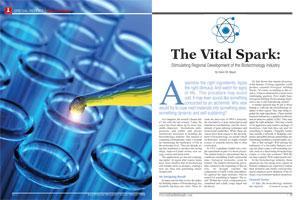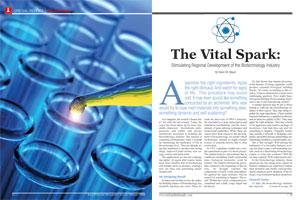

Assemble the right ingredients. Apply the right stimulus. And watch for signs of life. This procedure may sound odd. It may even sound like something concocted by an alchemist. Who else would try to coax inert materials into something alive, something dynamic and self-sustaining?
As it happens, the wizard’s dream didn’t die with the last wizard. Today, the cause has been taken up by more reputable characters – biochemists, entrepreneurs, and public and private institutions interested in building the biotechnology industry. But instead of conjuring a homunculus, today’s wizards are harnessing the machinery of life at the molecular level. They are already using this machinery to produce life-saving drugs, improved plant strains, new energy sources and much more.
The applications go beyond rearranging matter. In region after region, hopes have been kindled that biotechnology will remake entire economies, creating a new tax base and generating much-needed jobs.
An Intriguing Result
In many articles that review the industry-building impact of biotechnology, key scientific advances are cited. These include the discovery of DNA’s structure, the elucidation of gene transcription and translation mechanisms, and the development of gene-splicing techniques and monoclonal antibodies. While these advances have been crucial to the development of biotechnology, we needn’t dwell on them here. Instead, we might consider a piece of scientific history that is often overlooked.
In 1953, a graduate student ran a simple experiment as part of a thesis project. The student hoped to demonstrate that in conditions resembling Earth’s primordial state, biological molecules could be formed. The student followed the procedure outlined at the beginning of this article. He brought together the components of Earth’s early atmosphere. He applied the right stimulus. And he waited for something to happen. The result? Within the vessel, condensation accumulated and a dark, soupy liquid was produced.
He had shown that natural processes, in the absence of living organisms, could produce essential biological building blocks. Of course, as startling as this result is, it leaves unanswered a much more challenging question: How might basic biological building blocks arrange themselves into a self-reproducing system?
A similar question may be put to those hoping to cultivate the biotechnology industry in their region. They may bring together the right ingredients. (These include research institutions, a qualified workforce and an attractive quality of life.) They may apply the right stimulus. (This may consist of an aggressive and creative package of incentives.) And then they can wait for something to happen. (Tangible results may include a network of fledgling companies and public/private partnerships administering incubators, research parks, etc.)
But is that enough? Will putting the rudiments of a favorable business ecology into place cause a self-sustaining system, such as a functioning biotechnology cluster, to come into existence? Will the tax base expand? Will employment rise?
In the biotechnology industry, these questions are becoming more urgent as biotech companies are expected to realize their potential and finally yield profits, and as taxpayers grow skeptical of the efficacy of government-backed incentives.
Favored Status
To date, the biotechnology industry has enjoyed special consideration. Because the biotechnology industry is perceived to be the economic engine of the future, it has been at least partly immune to the objections occasionally raised against tax breaks and other incentives designed to influence business location decisions.
In August 2007, USA Today published an article that described how localities around the nation were considering ways of limiting or even revoking incentives. It also noted that some localities were exploring more subtle options, such as attaching new performance requirements to incentives.
The most dramatic example was from New York State. New York Governor Eliot Spitzer ordered an audit of firms that had received tax benefits to encourage them to locate in low-tax Empire Zones, which are part of an economic goals-development program that provides more than $600million a year in tax breaks. About one-third of the businesses benefiting from the program were informed that they had failed to meet 60 percent of the expected investment and job creation.
If such developments signal a trend toward greater scrutiny and stricter enforcement, development professionals trying to promote the biotechnology industry may emphasize distinctions between ordinary business incentives and those meant to benefit biotechnology firms.
Of course, biotechnology firms may be eligible for general incentives that might apply to any business, as well as incentives geared toward high-tech companies. Certain programs, however, might be of particular interest. These include net operating loss (NOL) transfer programs. NOL programs are designed to appeal to bioscience startups, which typically post losses, which would ordinarily negate the value of many typical incentives.
A prominent NOL program is being promoted in New Jersey. In this program, new or expanding biotechnology companies are allowed to turn their tax losses and credits into cash to grow their businesses. Approved businesses may “sell” their unused net operating loss carry-forwards and unused research and development tax credit carry-forwards, for at least 75 percent of the value of the tax benefit.
Programs of comparable subtlety may become more common, especially if large, attention-getting incentives programs attract opposition. For example, in June 2007, Massachusetts Governor Deval Patrick announced plans for a $1 billion biosciences initiative. The proposal included $500 million in bonds to pay for buildings and equipment, $250 billion in tax credits and other incentives, and $250 million in direct state spending for research grants and other programs. However, when hearings on the proposal commenced in October 2007, representatives of other industries lined up to protest the special consideration given to the biotechnology industry. They testified that state funds and tax credits should be distributed more evenly to help a range of industries operating in Massachusetts.
Right to Play
Several studies have noted that the biotechnology industry is highly concentrated and that most activity is clustered around a handful of metropolitan areas. These studies have also warned that latecomers – regions lacking dense concentrations of biotechnology activity –would find it difficult or even impossible to become serious biotechnology contenders. Such warnings, however, have been brushed aside. Practically every state makes a case for why it should be taken seriously, if only within a specialized niche.
The states may have a point. To date, biotechnology has been practically synonymous with pharmaceutical development. But that is only one of many biotechnology sectors. Other sectors include agriculture, materials science, toxic remediation, biofuels and medical equipment. It seems plausible that different sectors could provide opportunities for more than a handful of metropolitan centers. And currently unsung regions could leverage unique local advantages relevant to a particular sector, and thereby achieve prominence in that sector.
Other opportunities may arise if it becomes common for biotechnology companies to perform different functions in different locations. For example, a company may choose to carry out research and development in one location and manufacturing in another. The next step could be fragmentation of the entire value chain, in which case certain types of fragments might undergo consolidation. Conceivably, some regions might become especially attractive places to carry out specific functions. And this trend could even play out on a global scale as trade barriers fall and regulations become harmonized.
Already, there are hints that in the United States, a key competitive advantage might be access to capital markets. In 2006, The New York Times reported that finance in the United States was drawing biotechnology companies from overseas. Quite a few examples were cited. However, few jobs were involved. In most cases, only the company’s headquarters were moved to the United States. Other operations would remain behind. These included the more labor-intensive operations, such as research and development.
It is most likely that research and development will remain close to key universities and other research institutions. Manufacturing operations, however, could be sited according to other criteria, including proximity to markets.
Other functions could become regional specialties. For example, in a report issued by the Texas Biotechnology and Life Science Cluster, it was noted that Texas has long been a national leader in conducting clinical trials, especially in the cancer sector. Active clinical trials within the state were numbered at 2,782, more than any other. California, the state running the second-largest number of trials, had 1947.
The report stated, “Texas can use this leadership position to build the relationships necessary to accelerate the growth of the biotechnology cluster and job development through a more focused opportunity identification process and a global network.”
Beyond Individual Firms
For development authorities, a maturing biotechnology industry may present a new set of challenges. A nascent industry naturally leads development authorities to concentrate on startups and their needs. However, a thriving biotechnology industry is bound to include companies at various stages of development. To accommodate a wider range of companies, development authorities may adopt a more systematic approach. They may shift their focus from individual startups to a range of infrastructure elements.
Overall, these elements will maintain a kind of pipeline. At the beginning, incubators accommodate startups, which also benefit if sources of investment have been cultivated. A little further on, research parks accommodate incubator graduates. Or a region may offer more widely dispersed but still affordable laboratory space. It is not unheard of for developers to build speculative laboratory space. For example, in Seattle, BioMed Realty Trust broke ground on the 93,000-square-foot Fairview Research Center, a $35 million investment, even though it had no signed leases. In the same city, the Blume Company broke ground on a 183,000-square-foot facility that will be available to office or biotechnology tenants. The $75 million project is scheduled for completion in 2008.
Finally, a region may promote the development of pilot manufacturing plants and contract manufacturing facilities. Also, to accommodate biotechnology companies at this stage, a region may devote resources to workforce development. Whereas startups rely heavily on a relatively small number of Ph.D.s, companies at the manufacturing stage may draw on graduates of local community colleges or technical programs.
A study conducted for the benefit of authorities in the San Francisco Bay Area offered a range of suggestions: develop programs to enhance communication between high schools, community colleges and human resource departments; set up company-sponsored programs that include job shadowing and mentoring, work-study programs, and job fairs; create biotechnology company internships; and establish a workforce-training center.
To coordinate activities at all these levels and to encourage networking to facilitate movement from level to level, a region may choose to rely on a local biotechnology association or even a biotechnology center. A good example of such an institution is the North Carolina Biotechnology Center, located in Research Triangle Park.
This private, nonprofit institution is not a site for laboratory research or company incubation. Instead, its 66-member staff seeks to provide long-term economic and societal benefits to North Carolina by supporting biotechnology research, business and education statewide. According to the Biotechnology Center, this strategy avoids duplication of effort and uses limited resources more efficiently. Since 1984 the Biotechnology Center has invested more than $187 million in state monies to develop biotechnology statewide.
By focusing on infrastructure instead of individual firms, regional authorities not only set up a kind of pipeline, they also insulate themselves from criticism when individual companies decide to move out of the area. Also, some infrastructure elements may help promote industries other than biotechnology. For example, incubators, research parks, and laboratory space may prove useful to growing nanotechnology companies.
